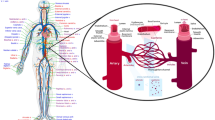Abstract
To understand flows through arterial bifurcations, a comprehensive literature survey covering both medical and engineering aspects of some of the related subject areas has been carried out. The salient results of this survey are discussed. Previous numerical studies of blood flow through arterial bifurcations are mostly restricted to two-dimensions. Three-dimensional modelling is difficult to perform due to the major disadvantages of large demands in computer storage and time. To solve this problem, a new line of approach using the latest parallel computer (CRAY X-MP) with currently available codes is presented. Two codes, FLOW3D and ASTEC, are assessed in detail.
Access this chapter
Tax calculation will be finalised at checkout
Purchases are for personal use only
Preview
Unable to display preview. Download preview PDF.
Similar content being viewed by others
References
Goldsmith H, Skalak R Hemodynamics. A Rev Fluid Mech 7: 213–247, 1975.
Skalak R, Keller S, Secomb T: Mechanics of blood flow ASME J Biomech Eng 103: 102–115, 1981.
Liepsch D: Flow in tubes and arteries-a comparison. Biorheology 23: 395–433, 1986.
Pedley T: The fluid mechanics of large blood vessels. Cambridge Univ Press, 1980.
Dinnar U: Cardiovascular fluid dynamics ( CRC ), Florida 1981.
Cam C, Pedley T, Schroter R et al: The mechanics of the circulation. Oxford Univ. Press, 1978.
Fernandez R, Witt K, Botwin M: Pulsatile flow through a bifurcation with applications to arterial disease. J Biomech 9: 575–580, 1976.
Ku D, Giddens D, Phillips D et al: Hemodynamics of the normal human carotid bifurcation: In vitro and in vivo studies. Ultrasound Med Biol 11: 13–26, 1985.
Ku d, Giddens D, Zarins C: Pulsatile flow and atherosclerosis in the human carotid bifurcation. Arteriosclerosis 5: 293–302, 1985.
O’Brien V, Ehrlich L, Friedman M: Unsteady flow in a branch. J Fluid Mech 75: 315–336, 1976.
O’Brien V, Ehrlich L: Simulation of unsteady flow at renal branches. J Biomech 10: 623–631, 1977.
Bharadvaj B, Mabon R, Giddens D: Steady flow in a model of the human carotid bifurcation. Part I-Flow visualization. J Biomech 15: 349–362, 1982.
Bharadvaj B, Mabon R, Giddens D: Steady flow in a model of the human carotid bifurcation. Part II-Laser Doppler anemometer measurements. J Biomech 15: 363–378, 1982.
Forster F, Chikos P, Frazier J: Geometric modelling of the carotid bifurcation in humans: implications in ultrasonic Doppler and radiologie investigation. J an Ultrasound 13: 385–390, 1985.
Ku D, Giddens D: Pulsatile flow in a model carotid bifurcation. Arteriosclerosis 3: 31–39, 1983.
Ku D, Giddens D: Laser Doppler anemometer measurements of pulsatile flow in a model carotid bifurcation. J Biomech 20: 407–421, 1987.
Lutz R, Hsu L, Menamat J, et al: Comparison of steady and pulsatile flow in a double branching arterial model. J Biomech 16: 753–766, 1983.
Deters O, Mark F, Bargeron C, et al: Comparison of steady and pulsatile flow near the ventral and vorsal walls of casts of human aortic bifurcations. ASME J Biomech Eng 106: 79–83, 1984.
Fukushima T, Homma T, Azuma T, et al.: Characteristics of secondary flow in steady and pulsatile flows through a symmetrical bifurcation. Biorheology 24: 3–12, 1987.
Liepsch D, Moravec S: Measurement and calculations of laminar flow in a ninety degree bifurcation. J Biomech 15: 473–485, 1982.
Perktold K, Hilbert D: Numerical simulation of pulsatile flow in a carotid bifurcation model. J Biomech 8: 193–199, 1986.
Rindt C, Vosse F, Steenhoven A et al: A numerical and experimental analysis of the flow field in a two-dimensional model of the human carotid artery bifurcation. J Biomech 20: 499–509, 1987.
Khodadadi J, Vlachos N, Liepsch D, et al: LDA measurements and numerical prediction of pulsatile laminar flow in a plane 90 degree bifurcation. J Biomech Eng 110: 129–136, 1988.
Wille S: Numerical simulation of steady flow inside a three dimensional aortic bifurcation model. J Biomed Eng 6: 49–55, 1984.
Dinner U, Enden G, Israeli M: A numerical study of flow in a three dimensional bifurcation. Cardiovascular Systems Dynamics Soc Meeting, Canada, 1988.
Ku D, Liepsch D: The effects of non-Newtonian viscoelasticity and wall elasticity on flow at a 90° bifurcation. Biorheology 23: 359–370, 1986.
Moravec S, Liepsch D: Flow investigation in a model of a three-dimensional human artery, with Newtonian and non-Newtonian fluids. part I. Biorheology 20: 745–759, 1983.
Gresho P: A modified finite element method for solving the time-dependent incompressible Navier-Stokes equations. Part I: Theory. Int J Num Meth in Fluids 4: 557–598, 1984.
Burns A, Jones I, Knightley J et al.: FLOW3D, release 2: user manual. UKAEA Report, AERE Harwell, 1987.
Burns A, Wilkes N: A finite difference method for the computation of fluid flows in complex 3D geometries. UKAEA Report, AERE-R 12342, 1987.
Rhie C, Chow W: A numerical study of the turbulent flow past an aerofoil with trailing edge separation. AIAA J 21: 1525–1532, 1983.
Burns D, Wilkes N, Jones I, et al: FLOW3D: Body fitted coordinates UKAEA Report, AERE-R12262, Harwell, 1986.
Lonsdale R An algorithm for solving thermal-hydraulic equations in complex geometry. The AS 1’EC code. UKAEA report, Dounreay, 1988.
Author information
Authors and Affiliations
Editor information
Editors and Affiliations
Rights and permissions
Copyright information
© 1990 Springer-Verlag Berlin Heidelberg
About this paper
Cite this paper
Xu, X.Y., Collins, M.W. (1990). Assessment of the Problem of Numerical Simulation of Blood Flow Through Three-Dimensional Bifurcations. In: Liepsch, D.W. (eds) Biofluid Mechanics. Springer, Berlin, Heidelberg. https://doi.org/10.1007/978-3-642-52338-0_58
Download citation
DOI: https://doi.org/10.1007/978-3-642-52338-0_58
Publisher Name: Springer, Berlin, Heidelberg
Print ISBN: 978-3-540-52730-5
Online ISBN: 978-3-642-52338-0
eBook Packages: Springer Book Archive




